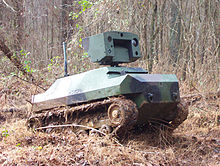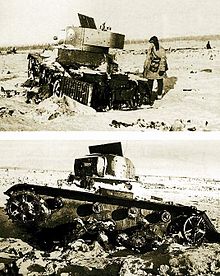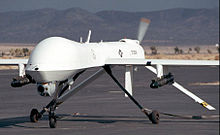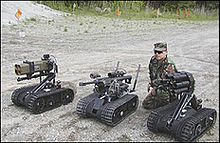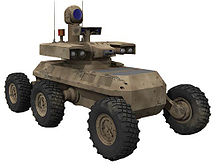- Military robot
-
"Artificial Soldier" redirects here. For the album by industrial group Front Line Assembly, see Artificial Soldier.
Military robots are autonomous robots or remote-controlled devices designed for military applications.
Such systems are currently being researched by a number of militaries.
Contents
History
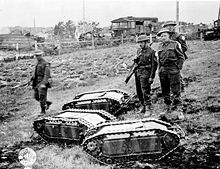 British soldiers with captured German Goliath remote-controlled demolition vehicles (Battle of Normandy, 1944).
British soldiers with captured German Goliath remote-controlled demolition vehicles (Battle of Normandy, 1944).
Broadly defined, military robots date back to World War II and the Cold War in the form of the German Goliath tracked mines and the Soviet teletanks. The MQ-1 Predator drone was when "CIA officers began to see the first practical returns on their decade-old fantasy of using aerial robots to collect intelligence".[1]
The use of robots in warfare, although traditionally a topic for science fiction, is being researched as a possible future means of fighting wars. Already several military robots have been developed by various armies.
Some believe the future of modern warfare will be fought by automated weapons systems.[2] The U.S. Military is investing heavily in research and development towards testing and deploying increasingly automated systems. The most prominent system currently in use is the unmanned aerial vehicle (IAI Pioneer & RQ-1 Predator) which can be armed with Air-to-ground missiles and remotely operated from a command center in reconnaissance roles. DARPA has hosted competitions in 2004 & 2005 to involve private companies and universities to develop unmanned ground vehicles to navigate through rough terrain in the Mojave Desert for a final prize of $2 Million.[3] The field of artillery has also seen some promising research with an experimental weapons system named "Dragon Fire II" which automates the loading and ballistics calculations required for accurate predicted fire, providing a 12 second response time to artillery support requests. However, weapons of warfare have one limitation in becoming fully autonomous: there remain intervention points which requires human input to ensure that targets are not within restricted fire areas as defined by Geneva Conventions for the laws of war.
There have been some developments towards developing autonomous fighter jets and bombers.[4] The use of autonomous fighters and bombers to destroy enemy targets is especially promising because of the lack of training required for robotic pilots, autonomous planes are capable of performing maneuvers which could not otherwise be done with human pilots (due to high amount of G-Force), plane designs do not require a life support system, and a loss of a plane does not mean a loss of a pilot. However, the largest draw back to robotics is their inability to accommodate for non-standard conditions. Advances in artificial intelligence in the near future may help to rectify this.
Examples
In current use
- DRDO Daksh
- Goalkeeper CIWS
- Guardium [5]
- PackBot
- MARCbot
- RQ-9 Predator B
- RQ-1 Predator
- TALON
- Samsung SGR-A1 [6]
- Gladiator Tactical Unmanned Ground Vehicle (used by the United States Marine Corps)
In development
- US Mechatronics has produced a working automated sentry gun and is currently developing it further for commercial and military use.
- MIDARS, a four-wheeled robot outfitted with several cameras, radar, and possibly a firearm, that automatically performs random or preprogrammed patrols around a military base or other government installation. It alerts a human overseer when it detects movement in unauthorized areas, or other programmed conditions. The operator can then instruct the robot to ignore the event, or take over remote control to deal with an intruder, or to get better camera views of an emergency. The robot would also regularly scan radio frequency identification tags (RFID) placed on stored inventory as it passed and report any missing items.
- Tactical Autonomous Combatant (TAC) units, described in Project Alpha study 'Unmanned Effects: Taking the Human out of the Loop' -
- Autonomous Rotorcraft Sniper System is an experimental robotic weapons system being developed by the U.S. Army since 2005.[7][8] It consists of a remotely operated sniper rifle attached to an unmanned autonomous helicopter.[9] It is intended for use in urban combat or for several other missions requiring snipers.[10] Flight tests are scheduled to begin in Summer 2009.[7]
- The "Mobile Autonomous Robot Software" research program was started in December 2003 by the Pentagon who purchased 15 Segways in an attempt to develop more advanced military robots.[11] The program was part of a $26 million Pentagon program to develop software for autonomous systems.[11]
Effects and impact
Advantages
Major Kenneth Rose of the US Army's Training and Doctrine Command outlined some of the advantages in robotic technology in warfare:[12] "Machines don't get tired. They don't close their eyes. They don't hide under trees when it rains and they don't talk to their buddies ... A human's attention to detail on guard duty drops dramatically in the first 30 minutes ... Machines know no fear."
Increasing attention is also paid to how to make the robots more autonomous, with a view of eventually allowing them to operate on their own for extended periods of time, possibly behind enemy lines. For such functions, systems like the Energetically Autonomous Tactical Robot are being tried, which is intended to gain its own energy by foraging for plant matter.
Potential risks
In 2009, academics and technical experts attended a conference to discuss the impact of the hypothetical possibility that robots and computers could become self-sufficient and able to make their own decisions. They discussed the possibility and the extent to which computers and robots might be able to acquire any level of autonomy, and to what degree they could use such abilities to possibly pose any threat or hazard. They noted that some robots have acquired various forms of semi-autonomy, including being able to find power sources on their own and being able to independently choose targets to attack with weapons. They also noted that some computer viruses can evade elimination and have achieved "cockroach intelligence." They noted that self-awareness as depicted in science-fiction is probably unlikely, but that there were other potential hazards and pitfalls.[13]
Some experts and academics have questioned the use of robots for military combat, especially when such robots are given some degree of autonomous functions.[14] The US Navy has funded a report which indicates that as military robots become more complex, there should be greater attention to implications of their ability to make autonomous decisions.[15][16]
In fictional media
See also
- Robot combat
- Unmanned Combat Air Vehicle
- Powered exoskeleton
- Network-centric warfare
- Roboethics
- Three laws of robotics
References
- ^ Steve Coll, Ghost Wars (Penguin, 2005 edn), pp.529 and 658 note 6.
- ^ Robots and Robotics at the Space and Naval Warfare Systems Center Pacific
- ^ DARPA Grand Challenge: Home
- ^ Technology Review: The Ascent of the Robotic Attack Jet
- ^ Guardium Military robot
- ^ Korean gun bots theregister.co.uk
- ^ a b Page, Lewis (21 April 2009). "Flying-rifle robocopter: Hovering sniper backup for US troops". The Register. http://www.theregister.co.uk/2009/04/21/arss_hover_sniper/. Retrieved 2009-04-21.
- ^ "U.S. Army Tests Flying Robot Sniper". Fox News. 2009-04-22. http://www.foxnews.com/story/0,2933,517481,00.html. Retrieved 2009-04-23.
- ^ Hambling, David (May 2009). "UAV Helicopter Brings Finesse to Airstrikes". Popular Mechanics. http://www.popularmechanics.com/technology/military_law/4313331.html. Retrieved 2009-04-21.
- ^ Hambling, David (April 21, 2009). "Army Tests Flying Robo-Sniper". Wired, "Danger Room" blog. http://blog.wired.com/defense/2009/04/army-tests-new.html#more. Retrieved 2009-04-21.
- ^ a b "Military wants to transform Segway scooters into robots". seattlepi.com. 2003-12-02. http://www.seattlepi.com/business/150662_segway02.html. Retrieved 2009-04-24.
- ^ "Robot soldiers". BBC News. 2002-04-12. http://news.bbc.co.uk/cbbcnews/hi/teachers/citizenship_11_14/subject_areas/scientific_development/newsid_1923000/1923299.stm. Retrieved 2010-05-12.
- ^ Scientists Worry Machines May Outsmart Man By JOHN MARKOFF, NY Times, July 26, 2009.
- ^ Call for debate on killer robots, By Jason Palmer, Science and technology reporter, BBC News, 8/3/09.
- ^ New Navy-funded Report Warns of War Robots Going "Terminator", by Jason Mick (Blog), dailytech.com, February 17, 2009.
- ^ Navy report warns of robot uprising, suggests a strong moral compass, by Joseph L. Flatley engadget.com, Feb 18th 2009.
External links
- "Biomass military robot in development"
- EATR: Energetically Autonmous Tactical Robot - Phase II Project
Organizations
- United States Joint Forces Command website: "Leading the transformation of the U.S. military"
- irobot.com, builder of the PackBot and the R-Gator systems
- Boston Dynamics, builder of BigDog
News articles/press releases
- USJFC: 'Robotics to play major role in future warfighting'
- "From bomb disposal to waste disposal" Robots help deal with hazards, emergencies and disasters (International Electrotechnical Commission, July 2011)
- "War robots still in Iraq", DailyTech, April 17, 2008
- New Model Army Soldier Rolls Closer to Battle (SWORDS)
- TALON Small Mobile Robot
- TWG Military Robots
- Carnegie Mellon University's snooping robot going to Iraq
- PackBot Battlefield robotic Platform
- Miniature Unmanned Aerial Systems - UAV
- Guardium Autonomous Security Vehicle
- Unmanned Ground Systems from Israel
- High-Tech Military in Due Course
- Launching a new kind of warfare
- Gerry J. Gilmore (January 24, 2006). "Army's Veteran Bomb-Disposal Robot Now 'Packs Heat'". American Forces Press Service. http://www.defenselink.mil/news/newsarticle.aspx?id=14536. Retrieved 2008-02-02.
- Interviews on ethical and legal aspects of Robotic Combat Systems
Mobile robots Ground OtherUnderwater Unmanned underwater vehicle (UUV) · Autonomous underwater vehicle (AUV) · Intervention AUV (I-AUV) · Remotely operated underwater vehicle (ROUV) · Underwater gliderSurface Aerial Space Other Domestic · Military · Rescue · Medical · Disability · Agricultural · BEAM robotics · Microbotics · NanoroboticsSee also: Unmanned vehicle · Robotics · Robot locomotion · Autonomous robot · Autonomous logistics · Radio-controlled model · Remote control vehicle · Remote-controlled animal · Categories: Radio control · Unmanned vehiclesRobotics (outline) Main articles Outline of robotics · Glossary of robotics · Index of robotics articles · History of robots · Robotics worldwide · Robot Hall of Fame · Roboethics · Robotic laws · Human-robot interaction · AI Competitions · Future of roboticsRobots Humanoids · Androids · Biomorphic · Hexapods · Industrial · Articulated · Domestic · Entertainment · Military · Medical · Service · Disability · Agricultural · Food service · BEAM robotics · Microbotics · Nanorobotics • List of robots · Fictional robotsRobot classification Robot locomotion Wheels · Tracks · Walking · Running · Swimming · Climbing · Hopping · Metachronal motion · Crawling · BrachiatingRobot navigation Robot research Roboticist · Areas · Evolutionary · Kits · Simulator · Suite · Open-source · Software · Adaptable · Developmental · Paradigms · UbiquitousCategories:- Russian inventions
- Soviet inventions
- Weapons
- Military robots
Wikimedia Foundation. 2010.

